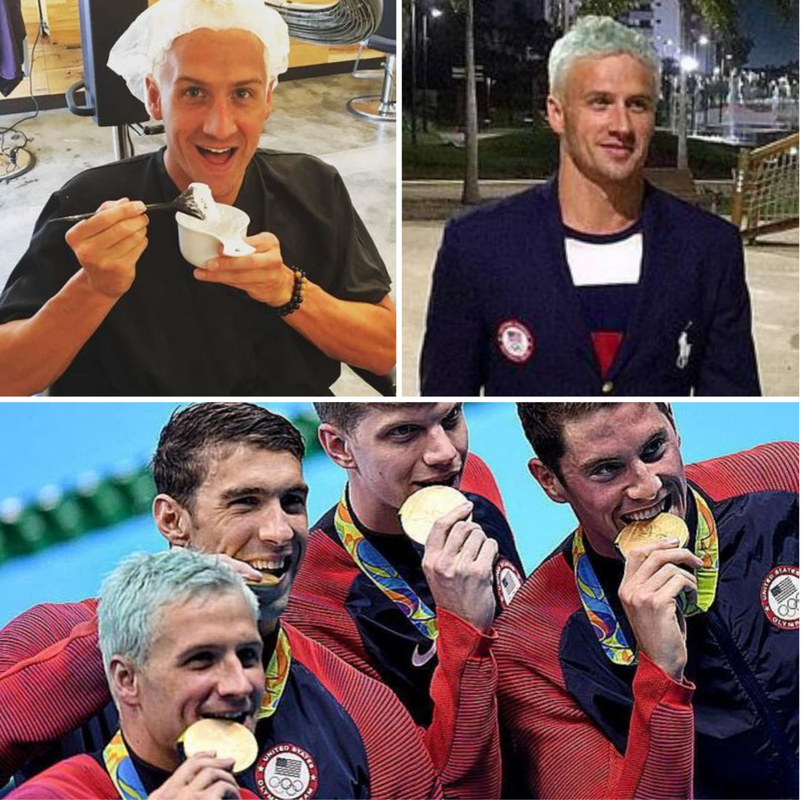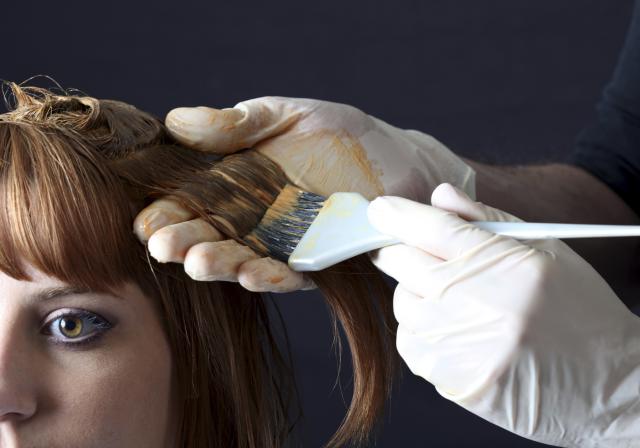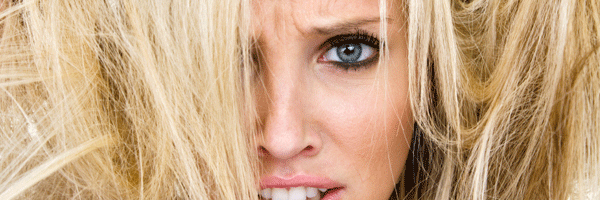|
8/15/2016 0 Comments Silver Fox to . . . Green Giant?Yes, chlorine can turn your blonde hair green. Sometimes, though, you just have to make the best of a bad situation (like Ryan Lochte did) at the Olympics.
US Olympic Swimmer Ryan Lochte's Unexpected Makeover
0 Comments
By Kendra Aarhus, Women's Hairstyles Expert
1 of 7 Is Your Hair Color Fading Problems all Your Fault? Whether you color your hair yourself (be careful, please) or you spend hundreds of dollars at the salon, some people just can't seem to catch a break with hair color fading. While some fading is to be expected, you may be surprised to learn that some of the reasons your hair color is fading is all your fault, and some of the things you always thought was fading your hair, really aren't at all. 2 of 7 Your Hair is Damaged Honesty is the best policy here. Is your hair damaged? Do you flat iron and curl it too often? Are your highlights damaging your hair? FACT: When you hair is damaged the cuticle of your hair doesn't seal down and the color escapes through this unsealed cuticle. You may have damage that you don't even realize. For example, if you use box color often or your hair is over processed, your hair's cuticle suffers un-repairable damage. MYTH: You can't reverse most damage that's already done to your hair, but there are a few things you can do to stop the damage and prevent future damage. Above all, be sure to discuss you hair's damage with your hair dresser and come up with a plan of products and services that can help prevent future damage. 3 of 7 Your Shampoo is Stripping Your Hair Color FACT: So often your hair color investment is literally washed down the drain by your shampoo. Shampoos can be full of sulfates and harsh detergents that wash everything off your hair, including the color. MYTH: Color safe shampoo will not fade color. The wrong shampoo can be the problem, but washing your hair too often is a guaranteed way to strip you color, no matter what kind of shampoo you use. While it's great to shop for shampoo that's sulfate free and color safe; you'll get more mileage out of your color if you put as many days between shampoos as possible. A great alternative to traditional shampoo is a cleansing conditioner, but do your homework before choosing a cleansing conditioner. Many are full of waxes that can cause serious long term damage to your hair. 4 of 7 Sun Exposure is Fading Your Hair FACT: The sun is one of the biggest culprits of hair color robbery. MYTH: Sunscreen for your hair will block UV rays and keep hair from fading. Ultra Violet protection is a lot easier with hair products these days, but even the best sun screen can't completely prevent color fade from sun exposure. If you know you're going to be spending a lot of time in the sun (yard word, beach days, or sporting events), investing in a hat that completely blocks UV rays is your best bet for sun protection. Do continue to use products that help deliver SPF protection. Even small doses of sun exposure add up to color fading and products that protect from UV rays can help minimize that exposure. 5 of 7 Your Water Temperature is Fading Your Hair MYTH: You've probably been told time and time again that you have to rinse your hair in cold water to keep your color from fading. This is a big fat myth, in my opinion. FACT: The fact is that rinsing your hair in warm water is okay, but it's not necessary to freeze in your final moments in the shower. Scalding hot water can open your cuticle, but rinsing in warm to slightly cool water is just fine. 6 of 7 Your Toner has Worn Off FACT: Toner wears off before your next hair color appointment. If your stylist used a toner to perfect your hair color or highlights, it'll probably wear off after 6 to 8 weeks. MYTH: You have to return to the salon to have your toner updated. You can keep your toner (which typically tones out yellow and brassy tones) fresh by self toning at home using self toning shampoos and conditioners. These products have a pigmented base that keep unwanted tones at bay or keep your color vibrant. 7 of 7 You're Not Deep Conditioning Your Hair FACT: Deep conditioning treatments will help restore shine and seal the cuticle of your hair, keeping the color locked in for longer. MYTH: Deep conditioning treatments are expensive and should be done at the salon. I love at home deep conditioning treatments, and some of my favorites are incredibly affordable. A weekly mask with a deep conditioning treatment will ensure your color lasts longer, and your hair will have more shine and vibrancy. While I was researching the "extinction of blondes" I came across similar claims about redheads.
Over the years many news organizations have reported that redheads or "gingers," would eventually become extinct. Other news outlets and blogs picked up the story, citing the "Oxford Hair Foundation" or "genetic scientists" who claimed that there would be no more redheads by as early as 2060. It turns out that all those people were wrong. Redheads are here to stay and should be around well beyond 2060. These articles work on the mistaken assumption that recessive genes -- like the one for red hair -- can "die out." Recessive genes can become rare but don't disappear completely unless everyone carrying that gene dies or fails to reproduce. So while red hair may remain rare, enough people carry the gene that, barring global catastrophe, redheads should continue to appear for some time. Some of the articles discussing redhead extinction referred to the Oxford Hair Foundation as an "independent" institute or research foundation, but a Google search shows that the Oxford Hair Foundation is funded by Proctor & Gamble, makers of numerous beauty products -- including red hair dye. In the most recent wave of redhead extinction warnings, some news outlets incorrectly cited the September 2007 issue of National Geographic as the source of the extinction claims. Others, correctly, cited that issue of National Geographic for the statistics it presented in a short piece on redheads. In fact, the National Geographic story provided some data about red hair in the world population, but it only said that "news reports" have claimed that redheads were going extinct. The piece did not explicitly back the claim. Instead, the article stated that "while redheads may decline, the potential for red isn't going away". Unfortunately the misconception about disappearing redheads is now widespread. Experts who have been interviewed agree that the redhead extinction claim is bogus. David Pearce from the University of Rochester Medical Center told the Rochester Democrat and Chronicle in 2005 -- after the last round of redhead extinction news -- that the scientists behind the original claim should "check their calculator". Rick Sturm, a researcher in hair and skin genetics at the University of Queensland, told the Australian Broadcasting Company that "there's no shortage of red-heads" and that the Oxford Hair Foundation didn't provide sufficient scientific evidence to prove its findings. Red hair is caused by a mutation in the MC1R gene. It's also a recessive trait, so it takes both parents passing on a mutated version of the MC1R gene to produce a redheaded child. Because it's a recessive trait, red hair can easily skip a generation. It can then reappear after skipping one or more generations if both parents, no matter their hair color, carry the red hair gene. (source: Science: HowStuffWorks) I was hanging out with a few friends earlier today and we were talking a hair (of course we were) and someone mentioned that there wouldn't be any more blondes in a few hundred years. I'd never heard this before so I thought I'd research their comment.
The Claim: A study undertaken by the World Health Organization concluded that natural blondes are likely to be extinct within 200 years. Well, this is completely FALSE. The problem is that blonde hair is caused by a recessive gene. In order for a child to have blonde hair, it must have the gene on both sides of the family in the grandparents' generation. The researchers also believe that so-called bottle blondes may be to blame for the demise of their natural rivals. They suggest that dyed-blondes are more attractive to men who choose them as partners over true blondes. But Jonathan Rees, professor of dermatology at the University of Edinburgh said it was unlikely blondes would die out completely. "Genes don't die out unless there is a disadvantage of having that gene or by chance. They don't disappear," he told BBC News Online. "The only reason blondes would disappear is if having the gene was a disadvantage and I do not think that is the case. "The frequency of blondes may drop but they won't disappear." [source: BBC News]. (Source: Science: HowStuffWorks) SNOPES.com also debunked this claim. Our stylists know things we don’t.
by Jo Confino Are we looking in the wrong place when it comes to finding champions who can turn us away from our environmentally destructive ways? Researchers at a university in the United Kingdom believe that hairdressers, rather than politicians, scientists or celebrities, could be the secret weapon in convincing us to reduce our carbon emissions. Given that hairdressers get up close and personal with billions of customers, they are the perfect vehicle for helping to change people’s behavior, according to Dr Denise Baden, an associate professor at the University of Southampton’s management school. Even better, they deal with many of the environmental challenges that need addressing, such as water and energy use as well as the toxins in many hair care products. A new study by Baden shows just how much difference people can make if they change their routines. A person who carries out a daily hair wash with two shampoos plus rinse-out conditioner creates a weekly carbon footprint of around 9 kilograms, or nearly 20 pounds of carbon emissions. But this could be cut down to just 1 kg (roughly 2 pounds) if they change to a twice-weekly hair wash using just one shampoo plus leave-in conditioner, the study says. Her research, which is funded by the U.K. government, also shows how important it is that hairdressers educate their clients to reduce the use of heated appliances such as hair straighteners, curlers and blow dryers. Not only does taking a more natural approach improve hair condition, but it also reduces energy costs and protects the planet, according to Baden. She and her team have now developed a carbon footprint calculator, which demonstrates the effect hair care routines have on the environment and points out five changes that can make a big difference: 1. Do not wash your hair every time you shower — and whatever your routine, allow an extra day to go before shampooing. 2. Shampoo once rather than rinse and repeat. 3. Cut down shower time by using a leave-in conditioner. 4. Shower rather than take a bath and limit the time to four minutes. 5. Let hair dry naturally. This is not the first time that hairdressers have been recognized for their potential to get important information to a mass audience. The United Nations Population Fund, in collaboration with UNAIDS Secretariat, back in 2009 identified barbershops and beauty salons in Guyana as information hubs to help reduce HIV. “We’re not asking hairdressers to become sustainability consultants or to compromise on standards,” Baden said in a written statement. “Instead, we’re trying to educate businesses that less is more and to spread this message to their clients. For example ... [p]roducts such as leave-in conditioner not only save energy, time and money but are also great for giving body to fine or flyaway hair.” “Our approach has been to train the trainers so they can in turn affect the behaviour of their clients,” she added. “Just one hairdresser can affect the practices of hundreds of clients.” The next step for Baden and fellow researchers is to develop a sustainable hairdressing certificate for salons, hairdressers and training colleges. While all this may seem like a clever approach to helping limit climate change, there is one key challenge that Baden has not yet been able to overcome. While hairdressers are often adept at chatting about topics ranging from relationships to the weather, they do not often make proactive change agents. As Baden pointed out in a 2014 interview: “Early adopters of social innovations characteristically have more years of formal education, greater rationality, higher IQ, higher aspirations and higher status occupations than late adopters. None of these attributes are typical of hairdressers. Therefore it is unsurprising that our pilot research found no examples of hairdressers taking the lead on sustainability innovations.” But the world is changed one person at a time, and Baden points to the feedback from one hairdresser who went through a sustainability-focused training session: “Taking that approach has given me more pride in my work and in my profession as a whole. I no longer feel like ‘a blonde with scissors,’ I feel like a professional who is making a difference.” |
Hair by BrianMy name is Brian and I help people confidently take on the world. CategoriesAll Advice Announcement Awards Balayage Barbering Beach Waves Beauty News Book Now Brazilian Treatment Clients Cool Facts COVID 19 Health COVID 19 Update Curlies EGift Card Films Follically Challenged Gossip Grooming Hair Care Haircolor Haircut Hair Facts Hair History Hair Loss Hair Styling Hair Tips Hair Tools Health Health And Safety Healthy Hair Highlights Holidays Humor Mens Hair Men's Long Hair Newsletter Ombre Policies Procedures Press Release Previous Blog Privacy Policy Product Knowledge Product Reviews Promotions Read Your Labels Recommendations Reviews Scalp Health Science Services Smoothing Treatments Social Media Summer Hair Tips Textured Hair Thinning Hair Travel Tips Trending Wellness Womens Hair Archives
January 2025
|
|
Hey...
Your Mom Called! Book today! |
Sunday: 11am-5pm
Monday: 11am-6pm Tuesday: 10am - 6pm Wednesday: 10am - 6pm Thursday: By Appointment Friday: By Appointment Saturday: By Appointment |






 RSS Feed
RSS Feed